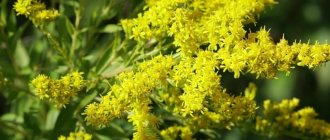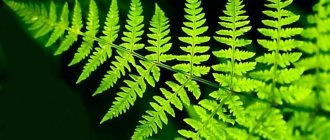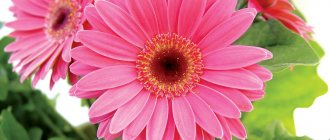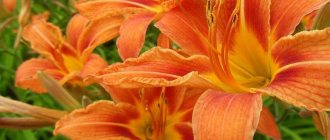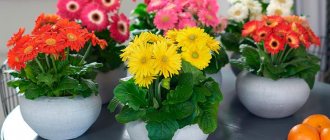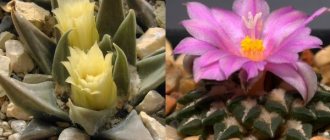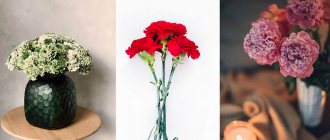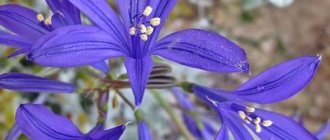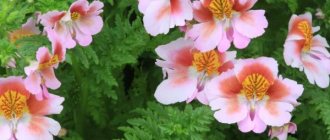Gerbera – translated from Latin (herba) means “grass”.
It is a perennial plant and belongs to the Asteraceae family. It has a low stem and a strong root system. Gerbera flowers are elegantly beautiful and come in a variety of colors. In appearance they are very similar to a large chamomile.
This flower is a heat-loving species, so it is grown in open ground only in southern countries.
Many gardeners grow flowers of the Asteraceae family, similar to gerberas.
Pyrethrum
He earned the respect of gardeners due to his unpretentiousness. You don't need any special skills to care for it. Cut inflorescences remain fresh for a long time. Protects nearby plants from pests.
Its petals are colored:
The bushes reach a height of 60 cm, the diameter of the inflorescence is 6 cm.
The birthplace of pyrethrum is the Balkan Peninsula.
Coreopsis
The annual or perennial shrub is called “garden sun”. Along the edges of the petals are painted in different bright colors: pink, brown, but the middle is invariably yellow. The peduncle, like a gerbera, is straight. Breeders have bred low-growing specimens suitable for growing on loggias and flowerpots. Picked plants retain their charming brightness for a long time.
Distribution area: Hawaiian Islands, Africa, America.
When and how do they bloom
Gerberas are planted as an annual or perennial plant primarily for their amazing flowers.
Types of flowers
Daisy flowers - description of what they look like
Depending on the color, there are yellow, white, red, pink and orange gerberas. Recently, a hybrid version has been in especially high demand - variegated flowers or crops with a shade of petals that varies in length.
Flower shapes
Depending on the shape of the petals, gerberas are wide-, medium-, and narrow-petaled. The flower has the shape of a basket, which is made up of two types of flowers. The central part has small tubular-type flowers, the edges are framed by false-ligulate flowers.
Flowering period
Gerbera is a kind of symbol that personifies the bright colors and rich colors of summer. The first period when the plant continues to bloom, if the proper conditions are created for it, or the climate allows, lasts from July to November. After this, a period of rest begins. It is very important - in winter the plant gains strength for new flowering. A new flowering period begins in February and ends in May. From May to July, the crop re-enters a dormant period.
Important! If you care for indoor gerberas correctly, they will bloom beautifully in the flowering-dormant mode for 3-4 years. After the designated period of time, the plant will need to be transplanted or completely replaced with a new one.
Echinacea
It is valued by gardeners for its long-lasting blooms and vibrant flowers. The plant has increased requirements for moisture. Cut inflorescences do not lose their decorative qualities from prolonged exposure to water. The straight, long stem grows up to 1.5 m. The flower petals are oblong and large. The tips have jagged edges.
The most common coloring of Echinacea is pink and yellow.
The homeland of the plant is North America. The Aborigines nicknamed it “deer root.” Nine varieties are used in gardening.
Calendula
The plant is herbaceous and belongs to the Asteraceae family. The flower is quite light-loving. Petal color:
Its stem and leaves are covered with villi. In addition to decorative varieties, calendula flowers have medicinal properties. It is also grown to saturate the soil with biologically active compounds that improve the soil structure.
It grows in the wild in Western Europe, Asia, and the Mediterranean.
Description
How dates grow, what date palms look like
The gerbera flower is a perennial plant that belongs to the Asteraceae family. This perennial is quite heat-loving, because as a garden flower in open ground it can only be safely planted in hot countries. If we talk about temperate latitudes, here gerbera is most often cultivated in greenhouses or planted in a pot as a beautiful indoor indoor flower.
The plant has a very developed root system. Its stem is quite short, with a rosette of roots that are light green in color. The peduncle is quite tall and pubescent. The gerbera flower most closely resembles a very large chamomile, the color of which can be very diverse (almost any shades except blue). Depending on the specific variety, it depends on exactly what gerbera flowers look like.
They can be:
- terry;
- semi-double;
- simple.
The size of the plant varies from 25 to 60 centimeters, the size of the inflorescence is from 4 to 15 centimeters.
Gatsania
Grown as an annual or perennial plant, gardeners have nicknamed it “African daisy.” Does not have any special requirements for personal care. Gatsania shrubs are drought-resistant and can survive without water for a long time. Flowers similar to gerberas are similar in their varied palette of colors, size and type of buds. They have orange or yellow inflorescences. They bloom from June to August.
Grows in Angola, Tanzania, South Africa, New Zealand.
Common varieties
Purslane - garden flowers, how they bloom and how they grow
Speaking about what gerberas are, we should consider their varieties in more detail. About 80 varieties of gerbera are found in nature. Most of them come from South Africa and Madagascar.
Terry gerberas look very original and stylish
Almost any modern gerbera is a hybrid, adapted for growing at home or in greenhouses. The following varieties are optimal for growing on window sills, in flower beds and in Russian gardens.
Gerber Jameson
In the case of Jameson's gerbera, cultivation can be carried out from seeds. She is the ancestor of a large number of hybrid forms.
Gerbera Jameson is a perennial shrub with slightly raised, feathery leaves collected in rosettes. The peduncle is quite thick. The diameter of the inflorescence is about 10 cm. Flowering continues for three weeks. The main feature of the Jameson variety is its bright colors.
Gerbera Klondike
Klondike gerbera is a popular hybrid variety. The plant is quite tall - about 45 cm. It requires minimal care, but the gerbera will bloom from July to October, and during the season it will produce about 50 flowers up to 11-12 cm in diameter.
Gerbera abyssinica
The Abyssinian variety is a perennial that grows up to 45 cm. The leaves have the shape of an ellipse and are formed into a basal rosette. With a length of the plates of just over 20 cm and a width of up to 14 cm, they have wavy or finely toothed notched edges. When the leaf is very young, it is covered with a light, barely noticeable fluff. Inflorescences are apical, solitary, white or with a reddish tint.
Gerbera Mini
Those who love beautiful homemade bright gerbera flowers are recommended to pay attention to Mini gerberas. This is the smallest and most compact variety, growing to a maximum of 30 cm in height. The description of the flower is approximately the following: the inflorescences are small, painted in rich yellow, orange or red colors. The Mini variety is highly valued for its decorative properties. The species looks great as a single planting and in combination with other flower crops.
Mini gerberas differ from other varieties only in the size of the inflorescences
Interesting. Many gardeners prefer to purchase Gerbera Mix seeds or combine individual varieties with flowers similar to gerberas. This approach allows you to get the most vivid results.
Rudbeckia
Like gerbera, it has powerful inflorescences, the circumference of which is up to 15 cm. The color palette is variegated and varied. There are 40 known species of rudbeckia; in our flower beds the most common one is bright yellow with a dark brown, slightly convex center. It is easy to care for and grows in one place for up to 5 years.
It has been used to decorate parks and gardens since the 17th century. Natural distribution area is North America.
Gerbera-like flowers
In nature there are a lot of flowers that look like gerberas.
The following flower crops are most often confused with them:
- Rudbeckia. Rudbeckia flowers are as large as gerberas. The color is most often bright yellow, the diameter is 15 cm. The difference lies in the core of the flower - in rudbeckia it is slightly convex and brown.
- Chrysanthemum. Chrysanthemum is also a frequent visitor to Russian gardening plots. Like the gerbera, it can be any color except blue. Caring for chrysanthemums is very simple; the culture gets along well in temperate climates.
- Pyrethrum. Pyrethrum is another flower that resembles a gerbera. Its petals are white, lilac, yellow, crimson or dark cherry. The difference from the described plant lies both in the height of pyrethrum - it grows up to 60 cm, and in the ease of care. In addition, pyrethrum grows well in cold climates.
- Calendula. Calendula, or, as this plant is popularly called, marigold, is another close relative of gerberas. The plant has an orange or bright yellow color. Moreover, calendula is a very interesting flower; its flowers have not only decorative value, but also healing value. They are very valuable raw materials for pharmaceuticals.
- Gatsaniya. Gazania is native to the South African region. It resembles a gerbera in all respects: color, size, color of leaves, shape of buds and flowers. The main difference is the presence of small spots at the base of the petals, somewhat reminiscent of the coloring of peacock feathers.
Without being an expert, it’s easy to confuse gazania with gerbera
This plant is cultivated both as a perennial and as an annual. Hanatia is unpretentious. The crop grows well on sandy and fairly poor soils and can survive without watering for a long period.
Arctotis
They resemble gerbera or chamomile and belong to the Astrov family. In its homeland (South Africa) it is a perennial. In regions with a temperate climate, it is grown as an annual herbaceous plant and blooms until mid-November. The height of the stems ranges from 20 to 100 cm. The color of arctotis petals is striking in its diversity:
Thanks to the efforts of breeders, many hybrid varieties have been obtained that are used in making bouquets.
From the origin story
It is not enough to learn how and where gerberas grow in nature; you also need to get acquainted with the history of flower culture. Not many people know, but the name “gerbera” is well known today, thanks to the famous botanist Jan Gronovius, who lived in the 18th century. At his suggestion, the flower began to be named in honor of his good friend, Traugott Gerber.
Gerberas simply amaze with their diversity
There is another theory - the name of the plant has Latin roots and comes from the word “herba” (grass).
Venidium
Venidium flowers attract attention with their outlandish colors. There are no dull and monochromatic colors among their kind. The color of the petals is varied:
- light chestnut;
- light resin;
- golden brown.
Gerbera-like inflorescences also have large baskets, their diameter is from 12 to 15 cm. The flowers stand in a vase for a long time and do not lose their attractiveness. The plant is warm and light-loving, its homeland is South Africa.
Erigeron
Herbaceous perennial. The height of the bushes is from 20 to 70 cm, the leaves are narrow. Flowers in circumference from 5 to 8 cm, with varied colors of petals. The inflorescences have crimson, yellow, scarlet, white and lilac colors. Translated from Latin, erigeron means early old man. Its seeds ripen quickly, but this does not interfere with long flowering (from June to October).
It grows wild in North America. There you can find up to 180 varieties of this species. The plant is unpretentious and loves moderate watering.
Anacyclus
Flowerbed flowers, which are white in color, are so similar to gerberas that not every experienced gardener can distinguish them at first sight. The substitution is detected by the size of the leaves; in anacyclus they are much smaller. The roots of the plant have medicinal properties.
Used as a ground cover crop. It blooms and grows well on poorly fertile soils, but is very demanding of sunlight. Growing area: North Africa, Mediterranean, Middle East.
Ursinia
Unpretentious, herbaceous annuals. With their striking appearance and basket-shaped inflorescences, they are similar to gerberas; they also belong to the Astrov family. The circumference of the inflorescences is 5-8 cm; 20-25 pieces bloom simultaneously on one bush. Color spectrum:
In Ursinia's homeland, Africa, there are 60 varieties.
The main purpose of plants similar to gerberas is to decorate flower beds. Bouquets made from them are popular because they remain fresh for a long time and do not have a cloying smell.
Gerbera - a large, bright "daisy" - looks great in bouquets. It is clear that flower growers would like to see this plant in their flower beds. However, gerbera, born in Africa and the tropical corners of Asia, is too delicate for central Russia - it can be grown in a greenhouse or at home (which is very troublesome), and as a kind of replacement, flowers similar to gerberas can be placed in a dacha or garden plot.
Description and photographs of flowers similar to gerbera
There are quite a lot of flowers that, like gerberas, belong to the Asteraceae family; they differ from each other in size and color of petals, but also have characteristic common features.
Rudbeckia
Rudbeckia flowers are as large as those of gerbera, their diameter reaches 15 cm. The color is usually bright yellow, although other options are possible, because rudbeckia is represented by four dozen species. The center of the flower is dark brown, slightly convex.
In its natural environment, the plant is found in North America. When European settlers first saw the flower, they called it “black-eyed Suzanne.”
Echinacea
The plant’s homeland is North America, where echinacea (locals gave it the name “deer root”) still feels good on river banks, since it is demanding of moisture. Like the gerbera, the flower has a long, up to one and a half meters, straight stem.
Gerbera: features of plant care
We are used to seeing bright gerberas in beautiful bouquet arrangements. But this beauty can be planted in a garden plot or admired in a room, placed in a container. Gerbera belongs to the perennial plants of the Aster family.
General information
Africa and the Asian tropics are considered the homeland of this large aster. It is described not only as a gerbera, but also as a Transvaal daisy or chamomile.
The flower is compact. Depending on the variety, the height of the plant ranges from small (25 cm) to tall (65 cm). Let us note the fact that the tall gerbera is only at the moment of its flowering. The height comes from the development of a leaf rosette; it is located near the surface of the ground.
The stem has many layers of leaves on short stalks. Leaf shape: dissected feathers, the center of the leaf is elongated. The pointed leaves can reach 30 cm in length. Color: dark green. Sometimes there is soft pubescence at the base of the leaf.
Garden gerbera blooms in August and September. The peduncle grows long, up to 80 cm, its entire surface is covered with pile. A peduncle grows from a leaf rosette. One may grow, but there may be several.
Only one flower blooms on a peduncle. Average basket size: from 10 to 16 cm. Hybrid gerberas are found with a basket up to 25 cm. There are a lot of petals, under the weight of them the gerbera slightly bows its head.
Description
In the center of the basket there are small tubular petals, of which a lot grows. They are always darker than the main petals. Yellowish or dark yellow centers are more common. Along the edges there are reed petals in several tiers; they are much longer than in the middle.
The colors of the petals are the most diverse: pink, red, white, crimson, orange. Gerberas bloom for a long time, almost 4 months!
Types of gerberas
If the flowers are pollinated, the seeds ripen, and inside there are dark, long seeds. When collected correctly, seeds do not lose their germination capacity for six months.
In nature, there are about 80 species of gerberas. Breeders have developed many hybrid varieties. They are imparted with many decorative qualities: plant height, basket size, petal color, flowering duration.
When creating hybrids, mainly two varieties of gerberas were used: Jameson and ordinary gerbera.
- The medium-sized variety of Jameson gerbera grows with a shortened stem. It is hidden in the basal leaves. The leaves are pinnate, dissected, with a pubescent peduncle growing between them (up to 26-35 cm). Gerbera inflorescences (from 5 to 16 cm) are very similar to chamomile.
- Green-leaved gerbera is distinguished by long, pointed leaves, very dense. Large inflorescences with pink, tongue-shaped petals. Peduncles can reach a meter in height.
All hybrid varieties are divided into subgroups. Here are the most popular types of gerbera:
- Mars is a large basket, with several tiers of wide petals. Peduncle about 60 cm. Variety of colors.
- Alcor - the flower basket is medium (6-8 cm), the petals are round. The leaves are narrow and long.
- Festival is a very beautiful variety. Large, pointed leaves. The peduncles are short, they bear a double inflorescence with medium-length petals. Variety of colors.
- Jupiter is an interesting flower basket: the petals are narrow, needle-shaped, in several tiers. Many colors.
Growing
"Daisies" blooming in summer
This selection contains 7 garden flowers, similar to chamomile, that bloom in the summer - from June to August.
Anacyclus (anacilus)
It’s not surprising to mistake Anacyclus for a chamomile - it really looks surprisingly similar to this flower. In nature, there are more than a dozen species of this charming plant.
Anaciluses are both perennial and annual. The most commonly grown annuals in flower beds are Anacyclus clavaceae and Anacyclus radiata. The most common of perennials is Anacyclus depressum.
Blooms from late spring to mid-summer: from May to July.
Helichrysum daisy flower
Of course, it is difficult to confuse Helichrysum daisy flower with chamomile, but their inflorescences do have something in common.
There are several common perennial species of immortelle, but in gardens they are usually grown as annuals and biennials.
The most popular helichrysums in flower beds in the middle zone are bractose (popularly known as immortelle), awl-leaved, and helmet-shaped. More exotic ones are helichrysum coral-shaped, helichrysum Milfordova, helichrysum selago, etc. - at first it can even be mistaken for sedums.
Helichrysum daisy flower blooms in June-August.
Doronicum (kozulnik)
This yellow “daisy” is ideal for rock gardens and rockeries, because its homeland is mountains. Doronicum is a perennial plant. Height varies depending on the species. The smallest are Doronicum Altai and Doronicum Cluse, the height of their bushes starts from 10 cm. And the stately Doronicum Kolyumna, for example, can reach all of 80 cm.
A selection of charming flowers that look like daisies
Adding an article to a new collection
In this article we have collected for you the names and photos of the most common flowers that look like daisies.
If you are wondering what the name of that big flower that looks like a daisy is called, we are here to help you! Check out our selection of plants that resemble this romantic, demure flower.
“Daisies” blooming in summer
This selection contains 7 garden flowers, similar to chamomile, that bloom in the summer - from June to August.
Anacyclus (anacilus)
It’s not surprising to mistake Anacyclus for a chamomile - it really looks surprisingly similar to this flower. In nature, there are more than a dozen species of this charming plant.
Anaciluses are both perennial and annual. The most commonly grown annuals in flower beds are Anacyclus clavaceae and Anacyclus radiata. The most common of perennials is Anacyclus depressum.
Blooms from late spring to mid-summer: from May to July.
Helichrysum daisy flower
Of course, it is difficult to confuse Helichrysum daisy flower with chamomile, but their inflorescences do have something in common.
agreement to terminate the lease of non-residential premises
There are several common perennial species of immortelle, but in gardens they are usually grown as annuals and biennials.
The most popular helichrysums in flower beds in the middle zone are bractose (popularly known as immortelle), awl-leaved, and helmet-shaped. More exotic ones are helichrysum coral-shaped, helichrysum Milfordova, helichrysum selago, etc. - at first it can even be mistaken for sedums.
Helichrysum daisy flower blooms in June-August.
Doronicum (kozulnik)
This yellow “daisy” is ideal for rock gardens and rockeries, because its homeland is mountains. Doronicum is a perennial plant. Height varies depending on the species. The smallest are Doronicum Altai and Doronicum Cluse, the height of their bushes starts from 10 cm. And the stately Doronicum Kolyumna, for example, can reach all of 80 cm.
